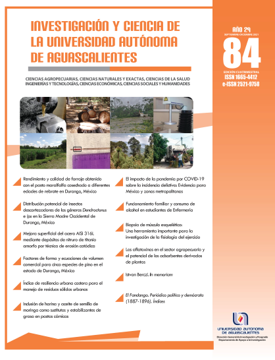Form factor and merchantable volume equations for five pine species in Durango state, Mexico
DOI:
https://doi.org/10.33064/iycuaa2021842815Keywords:
Taper-volume; Fang; autoregressive model; form coefficient; volume modelAbstract
Knowledge of the stem form of trees is important for estimating the wood volume of a forest. The objective of this study was to develop merchantable volume equations and form factors for five pine species from the forest region El Salto, Durango, Mexico. The raw data were obtained from 840 trees by destructive sampling. Eight volume models were fitted to estimate the stem volume, as well as a compatible taper-volume function to calculate the merchantable volume. Model parameters were obtained with SUR estimation (Seemingly Unrelated Regression). Weighted regression and a second-order autoregressive model were used to correct the heteroscedasticity and autocorrelation of the data, respectively. The average form factor was greater than 0.5 for all species, which differs from that traditionally used in the region (0.6).
Downloads
References
• Barrio Anta, M., Diéguez-Aranda, U., Castedo-Dorado, F., Álvarez González, J. G., & von Gadow, K. (2007). Merchantable volume system for pedunculate oak in northwestern Spain. Annals of Forest Science, 64(5), 511-520. doi: 10.1051/forest:2007028
• Bi, H. (2000). Trigonometric variable-form taper equations for Australian eucalyptus. Forest Science, 46(3), 397-409. doi: 10.1093/forestscience/46.3.397
• Burkhart, H. E., & Tomé, M. (2012). Modeling forest trees and stands. London: Springer.
• Corral-Rivas, J. J., Diéguez-Aranda, U., Corral Rivas, S., & Castedo-Dorado, F. (2007). A merchantable volume system for major pine species in El Salto, Durango (Mexico). Forest Ecology and Management, 238(1-3), 118-129. doi: 10.1016/j.foreco.2006.09.074
• Cruz-Cobos., F., Santos-Posadas, H. M., & Valdez-Lazalde, R. (2008). Sistema compatible de ahusamiento-volumen para Pinus cooperi Blanco en Durango, México. Agrociencia, 42(4), 473-485. Recuperado de http://www.scielo.org.mx/pdf/agro/v42n4/v42n4a10.pdf
• Diéguez-Aranda, U., Castedo-Dorado, F., Álvarez-González, J. G., & Rojo, A. (2006). Compatible taper function for Scots pine plantations in northwestern Spain. Canadian Journal of Forest Research, 36(5), 1190-1205. doi: 10.1139/x06-008
• Diéguez-Aranda, U., Rojo-Alboreca, A., Castedo-Dorado, F., Álvarez-González, J. G., Barrio-Anta, M., Crecente-Campo, F.,… Sánchez Rodríguez, F. (2009). Herramientas selvícolas para la gestión forestal sostenible en Galicia. Lugo, España: Xunta de Galicia.
• Fang, Z., Borders, B. E., & Bailey, R. L. (2000). Compatible volume-taper models for loblolly and slash pine based on a system with segmented-stem form factors. Forest Science, 46(1), 1-12. doi: 10.1093/forestscience/46.1.1
• Furlan Gama, F., Dos Santos, J. R., & Mura, J. C. (2010). Eucalyptus biomass and volume estimation using interferometric and polarimetric SAR data. Remote Sensing, 2(4), 939-956. doi: 10.3390/rs2040939
• García-Espinoza, G. G., Aguirre-Calderón, O. A., Vargas-Larreta, B., Martínez-Angel, L., García-Magaña, J. J., & Hernández-Ramos, J. (2019). Sistema compatible de ahusamiento y volumen comercial de Pinus pseudostrobus Lindl. en Nuevo San Juan Parangaricutiro, Michoacán, México. Agrociencia, 53(1), 115-131. Recuperado de https://agrociencia-colpos.mx/index.php/agrociencia/article/view/1755/1755
• Quiñonez Barraza, G., García Espinoza, G. G., & Aguirre-Calderón, O. A. (2018). ¿Cómo corregir heterocedasticidad y autocorrelación de residuales en modelos de ahusamiento y crecimiento en altura? Revista Mexicana de Ciencias Forestales, 9(49), 28-59. doi: 10.29298/rmcf.v9i49.151
• Quirós, R., Chinchilla, O., & Gómez, M. (2005). Rendimiento en aserrío y procesamiento primario de madera proveniente de plantaciones forestales. Agronomía Costarricense, 29(2), 7-15. Recuperado de http://www.infobosques.com/descargas/biblioteca/412.pdf
• SAS Institute Inc. (2004). SAS/ETS© 9.1 User’s Guide [Manual de usuario]. NC, US: SAS Institute Inc. Recuperado de https://support.sas.com/documentation/onlinedoc/91pdf/sasdoc_91/ets_ug_7314.pdf
• Tlaxcala-Méndez, R. M., De los Santos-Posadas, H. M., Hernández-De la Rosa, P., & López-Ayala, J. L. (2016). Variación del factor de forma y el ahusamiento en procedencias de cedro rojo (Cedrela odorata L.). Agrociencia, 50(1), 89-105. Recuperado de https://agrociencia-colpos.mx/index.php/agrociencia/article/view/2369
• Uranga-Valencia, L. P., De los Santos-Posadas, H. M., Valdez-Lazalde, J. R., López-Upton, J., & Navarro-Garza, H. (2015). Volumen total y ahusamiento para Pinus patula Schiede ex Schltdl. et Cham. en tres condiciones de bosque. Agrociencia, 49(7), 787-801. Recuperado de http://www.scielo.org.mx/pdf/agro/v49n7/v49n7a7.pdf
• Vargas-Larreta, B., Corral-Rivas, J. J., Aguirre-Calderón, O. A., López-Martínez, J. O., De los Santos-Posadas, H. M., Zamudio Sánchez, F. J.,… Aguirre-Calderón, C. G. (2017). SiBiFor: Forest Biometric System for forest management in Mexico. Revista Chapingo Serie Ciencias Forestales y del Ambiente, 23(3), 437-455. doi: 10.5154/r.rchscfa.2017.06.040
• Zavala Zavala, D. (1996). Coeficientes de aprovechamiento de trocería de pino en aserraderos banda. Revista Ciencia Forestal en México, 21(79), 165-181. Recuperado de http://cienciasforestales.inifap.gob.mx/index.php/forestales/article/view/1004/2309
• Zobel, B., & Talbert, J. (1988). Técnicas de mejoramiento genético de árboles forestales. Ciudad de México, México: Editorial Limusa
Downloads
Published
How to Cite
License
Copyright (c) 2021 Benedicto Vargas-Larreta, Carlos Enrique Aguirre-Calderón, Cristóbal Gerardo Aguirre-Calderón, Francisco Javier Hernández

This work is licensed under a Creative Commons Attribution-NonCommercial-ShareAlike 4.0 International License.
Las obras publicadas en versión electrónica de la revista están bajo la licencia Creative Commons Atribución-NoComercial-CompartirIgual 4.0 Internacional (CC BY-NC-SA 4.0)









